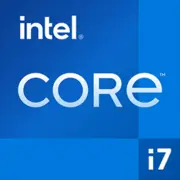Intel Core i7-13700KF

Intel Core i7-13700KF: Complete Overview of the 2025 Processor
Raptor Lake Architecture, 16 Cores, and Flagship Performance for Gamers and Professionals
Key Specifications: The Power of Raptor Lake
Architecture and Process Technology
The Intel Core i7-13700KF processor, released at the end of 2023, remains relevant in 2025 thanks to the hybrid Raptor Lake architecture. It combines 8 Performance-cores (P-cores) with Hyper-Threading support (16 threads) and 8 Efficient-cores (E-cores), totaling 16 cores and 24 threads. The Intel 7 process (10nm Enhanced SuperFin) delivers high energy efficiency and clock speeds of up to 5.4 GHz in turbo mode.
Key Features:
- Support for PCIe 5.0 for graphics cards and NVMe storage.
- Intel Thread Director technology for optimizing load between P-cores and E-cores.
- 30 MB of L3 cache, speeding up the processing of complex tasks (e.g., rendering in Blender).
Performance
According to Geekbench 6 (2025):
- Single-Core: 2875 — ideal for gaming and applications focusing on a single core.
- Multi-Core: 17570 — outperforms many processors in its class in rendering and multi-threaded tasks.
In practice, in games (e.g., Cyberpunk 2077 with RT Ultra), the processor consistently delivers over 120 FPS when paired with an RTX 4070 Ti at 1440p resolution.
Compatible Motherboards: Choosing the Foundation
Socket and Chipsets
The processor uses the LGA 1700 socket, compatible with the following chipsets:
- Z790 (top choice): Overclocking support, PCIe 5.0 x16, up to 4 NVMe slots. Examples: ASUS ROG Strix Z790-E Gaming ($350-400).
- B760 (budget option): Overclocking is limited, but PCIe 5.0 support for graphics cards is available. Example: MSI B760 Tomahawk WiFi ($180-220).
- H770 (mid-range): Suitable for workstations without overclocking.
Tip: For maximum performance, choose motherboards with VRM of at least 14 phases (e.g., Gigabyte Z790 Aorus Master) to avoid overheating under load.
Supported Memory: DDR4 vs DDR5
The processor supports DDR4-3200 and DDR5-5600, but motherboards generally support only one type.
- DDR5 (recommended): Provides a performance boost of up to 15% in gaming and high-bandwidth tasks (e.g., 4K editing).
- DDR4 (economical): Suitable for those upgrading from an older system.
Example: A 32 GB DDR5-6000 kit (Corsair Vengeance) costs around $120-150, while a 32 GB DDR4-3600 kit costs $80-100.
Power Supply: Power Calculation
With a TDP of 125 Watts and peak consumption of up to 250 Watts (when overclocked), the minimum recommended power supply wattage is 750 Watts. For systems with top-tier graphics cards (e.g., RTX 4090), it's better to opt for 850-1000 Watts.
Recommendations:
- Corsair RM850x (80+ Gold, $140-160) — quiet and reliable.
- Seasonic Prime TX-1000 (80+ Titanium, $250) — for enthusiasts.
Important: Don’t skimp on the power supply — unstable power can shorten the lifespan of components.
Pros and Cons
Advantages:
1. Versatility: Gaming, streaming, rendering — handles everything well.
2. Support for DDR5 and PCIe 5.0 — future-proofing.
3. Price: Approximately $380-420 (new), which is cheaper than the Ryzen 9 7900X ($450).
Disadvantages:
1. Heat Generation: Without a quality cooler (e.g., Noctua NH-D15 or Arctic Liquid Freezer II 360), temperatures can reach 90°C under load.
2. No integrated graphics — a discrete graphics card is required.
Use Cases
Gaming
The processor does not create a bottleneck even for an RTX 4090. In CS2 and Dota 2 (1080p), FPS exceeds 300.
Work Tasks
- Video Editing: Rendering a 30-minute 4K video in Premiere Pro takes about 12 minutes (compared to ~18 minutes with the i7-12700K).
- 3D Modeling: Stable operation in Autodesk Maya and SolidWorks with heavy scenes.
Multimedia
Streaming in OBS with NVENC encoding has virtually no impact on FPS in games.
Comparison with Competitors
1. AMD Ryzen 9 7900X:
- Pros: Better energy efficiency, integrated GPU.
- Cons: More expensive ($450), lags 5-7% in gaming performance.
2. Intel Core i9-13900K:
- Pros: Higher multi-threaded performance (24 cores).
- Cons: Price ($550-600), runs hotter.
Conclusion: The i7-13700KF is the sweet spot between price and power.
Practical Assembly Tips
1. Cooling: A liquid cooling system or a top-tier air cooler is essential.
2. Case: At least three fans for airflow (e.g., Lian Li Lancool III).
3. Motherboard: For overclocking — only Z790; for office builds — B760.
Example build for $1500:
- CPU: i7-13700KF ($400)
- GPU: RTX 4070 Super ($600)
- RAM: 32 GB DDR5-6000 ($130)
- PSU: Corsair RM850x ($150)
Final Verdict: Who Should Consider the i7-13700KF?
This processor is ideal for:
- Gamers looking for maximum FPS without paying for an i9.
- Content Creators: Editing, 3D, streaming — all tasks performed smoothly.
- Enthusiasts who appreciate the balance of price and performance.
Alternatives: If integrated graphics are needed, consider the i7-13700K. For pure multi-threaded performance, choose AMD Ryzen 9 7900X, but be prepared to pay more.
In 2025, the i7-13700KF remains one of the best choices for high-performance PCs without overpaying for flagship chips.
Basic
CPU Specifications
Memory Specifications
Miscellaneous
Benchmarks
Compared to Other CPU
Share in social media
Or Link To Us
<a href="https://cputronic.com/cpu/intel-core-i7-13700kf" target="_blank">Intel Core i7-13700KF</a>